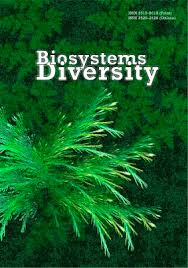The small-scale variation of herb-layer community structure in a riparian mixed forest
The small-scale variation of herb-layer community structure in a riparian mixed forest
Author(s): Y. O. Zhukova, N. V. Yorkina, V. S. Budakova, O. M. KunakhSubject(s): Energy and Environmental Studies, Methodology and research technology, Sociobiology
Published by: Дніпропетровський національний університет імені Олеся Гончара
Keywords: overstorey structure; soil properties; spatial pattern; phytoindication; scalogram; spatial eigenvector mapping;
Summary/Abstract: The ground vegetation layer is the most diverse plant community in forest ecosystems. We have shown the role of spatial variables, soil properties and overstorey structure in spatial variation of the herb-layer community in a riparian mixed forest . The research was conducted in the "Dnipro-Orils’kiy" Nature Reserve (Ukraine). The research polygon was located in the forest in the floodplain of the River Protich, which is a left tributary of the River Dnipro. Plant abundance was quantified by measuring cover within an experimental polygon. The experimental polygon consisted of 7 transects, each comprising 15 test points. The distance between the rows in the site was 3 m. At the site we established a plot of 45 × 21 m, with 105 subplots of 3 × 3 m organized in a regular grid. A list of vascular plant species was composed for each 3 × 3 m subplot along with visual estimates of species cover projection. The plant community was represented by 43 species, of which 18.6% were phanerophytes, 39.5% were hemicryptophytes, 9.3% were therophytes, 7.0% were geophytes. An overall test of random labelling revealed the total nonrandom distribution of the tree stems within the site. The species-specific test of random labelling showed the nonrandom segregated distribution of Acer tataricum, Pyrus communis, Quercus robur, and Ulmus laevis. Crataegus monogyna and Euonymus europaeus were distributed randomly. The nearest neighbour of Acer tataricum was less likely to be Ulmus laevis. There was no direct spatial connection between Acer tataricum and other trees. Crataegus monogyna, Pyrus communis, Quercus robur and Euonymus europaeus were not segregated from all other species. The nearest neighbour of Ulmus laevis was less likely to be Acer tataricum. Constrained correspondence analysis (CCA) was applied as ordination approach. The forward selection procedure allowed us to select 6 soil variables which explain 28.3% of the herb-layer community variability. The list of the important soil variables includes soil mechanical impedance (at the depth 0–5, 30–35, 75–80, and 95–10 cm), soil moisture, and soil bulk density. The variation explained by pure spatial variables accounted for 11.0 %. The majority of the tree-distance structured variation in plant community composition was broad-scaled. The spatial scalograms were left-skewed asymmetric. Significant relationship was found between the pure spatial component of the community variation and a number of phytoindicator estimations, most important of which were the variability of damping and humidity. Tree stand was obseerved to be a considerable factor structuring both the herb-layer community and spatial variation of the physical properties of soil.
Journal: Biosystems Diversity
- Issue Year: 28/2020
- Issue No: 4
- Page Range: 390-398
- Page Count: 9
- Language: English

